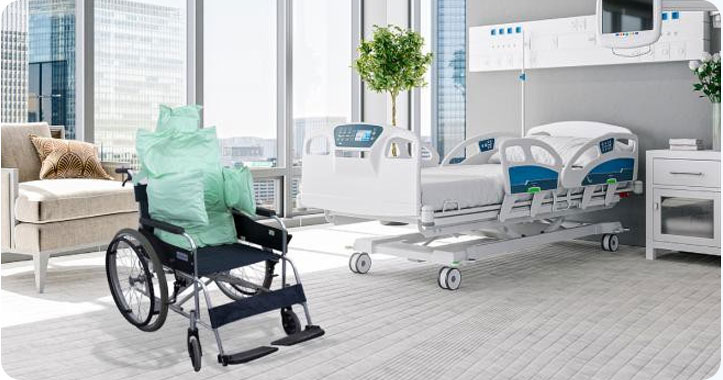With the advancement of modern medical technology, the requirements for patient rehabilitation treatment have gradually increased. Particularly in hospital rehabilitation departments, proper patient positioning is not only crucial for treatment outcomes but also directly affects comfort and recovery speed. Against this backdrop, rehabilitation positioning pads have emerged as an excellent solution for postural support due to their innovative design and practical functionality.

Key Features of Rehabilitation Positioning Pads
Rehabilitation positioning pads are auxiliary tools made of polymer film, designed to overcome the limitations of traditional postural support methods while providing patients with a safe, comfortable, and efficient rehabilitation experience. Below are the key features of these positioning pads:
1. Safety and Comfort
Rehabilitation positioning pads are made of polymer film, which is antibacterial, highly breathable, and soft to the touch. This design helps prevent discomfort or infections caused by material-related issues during rehabilitation while ensuring secure postural support.
2. Replacement for Traditional Methods
Traditional positioning methods, such as surgical positioning frames or pillows, often fail due to insufficient hardness or design flaws, leading to pressure on blood vessels and nerves, thereby increasing rehabilitation risks. In contrast, rehabilitation positioning pads are meticulously designed to evenly distribute pressure, effectively eliminating these shortcomings.
3. Easy to Clean and Disinfect
Rehabilitation positioning pads are structurally stable and resistant to collapse, with surfaces that are easy to clean and disinfect. Compared to traditional tools, they effectively prevent pressure ulcers, ensure skin health, and reduce the risk of infection.
4. Promotes Venous Return
By maintaining specific postures after molding, rehabilitation positioning pads help keep the affected area above heart level. This design promotes venous return, reduces localized swelling, and enhances the recovery process.
5. Easy to Shape
These pads are highly adaptable and can be customized based on the patient's condition. More importantly, they allow for posture adjustments at different rehabilitation stages, preventing secondary injuries caused by improper fixation and thus better supporting the rehabilitation process.
6. Antibacterial Material
Rehabilitation positioning pads use imported antibacterial polymer materials, effectively preventing cross-infection between patients. This is particularly significant in hospital rehabilitation departments, where patient density is high.
7. Compatibility with Medical Imaging
A standout feature of rehabilitation positioning pads is their compatibility with imaging applications. They are 100% suitable for X-ray, MRI, and CT scans, meeting the dual needs of rehabilitation treatment and imaging diagnostics.
8. Simple Operation
With a user-friendly design, rehabilitation positioning pads are easy to operate. Medical staff can quickly secure patients in place, reducing manual labor and eliminating safety risks associated with manual positioning, thus improving work efficiency.
Application Scenarios of Rehabilitation Positioning Pads
Rehabilitation positioning pads are primarily used in hospital rehabilitation departments to provide postural support during various rehabilitation treatments. These devices not only enhance patient treatment experiences but also significantly improve the operational efficiency of rehabilitation departments. Key application scenarios include:
1. Post-Surgical Rehabilitation
For post-surgical patients, rehabilitation positioning pads offer stable postural support, reducing physical strain during recovery and effectively preventing complications.
2. Imaging-Assisted Diagnosis
Due to their compatibility with imaging examinations, these pads serve as ideal auxiliary tools. During CT, MRI, or X-ray scans, they help maintain optimal patient positioning, leading to clearer imaging results and aiding in accurate diagnosis.
3. Long-Term Rehabilitation Care
For patients who are bedridden for extended periods or require continuous rehabilitation care, the soft yet stable support of these pads prevents pressure ulcers and other complications associated with prolonged immobility.
Advantages and Significance of Rehabilitation Positioning Pads
The widespread adoption of rehabilitation positioning pads has not only improved patient recovery quality but also optimized treatment workflows in healthcare institutions. The main advantages and their impact on the medical industry include:
1. Enhanced Patient Comfort
The use of soft, comfortable materials and precise postural support significantly reduces patient pain and discomfort, providing a superior treatment experience.
2. Improved Treatment Outcomes
By optimizing posture, promoting venous return, and reducing pressure-related issues, rehabilitation positioning pads directly contribute to faster and more effective patient recovery.
3. Increased Medical Efficiency
Their quick and easy operation saves significant time for medical staff, allowing them to focus more on treatment and care, thereby improving the overall utilization of medical resources.
4. Reduced Infection Risk
The use of antibacterial materials minimizes the risk of cross-infection, providing a safer treatment environment for patients.
As an advanced postural support solution, rehabilitation positioning pads have revolutionized hospital rehabilitation departments. Their safe and comfortable design, multifunctional applications, and efficient usability not only improve the patient rehabilitation experience but also significantly enhance the service quality of medical institutions. With continuous technological advancements and wider adoption, rehabilitation positioning pads are set to benefit more patients and drive further progress in the healthcare industry.



